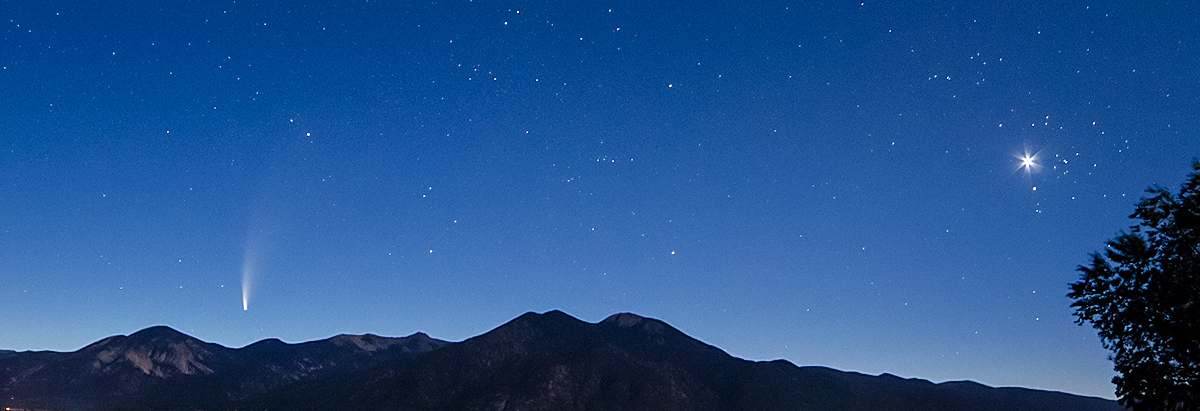

Welcome to taosastronomer.com!
offering
local "hands-on" observing
(visual and imaging) sessions and instruction
viewing and imaging from Rabbit Valley Observatory
a dark sky location on the mesa just west of Taos, NM
"Kohoutek" -- 01/14/74 from Genesee Park, CO
4-minute time exposure -- 135mm f/2.8 on Kodak Tri-X film pushed to ASA 1200 from ASA 400 -- exposed on a "driven" mount to mimic/nullify the Earth's rotation -- then film "pushed" to gain speed/sensitivity. Now (note date, 1974!) this is often unnecessary, as excellent (and non-grainy) films are available in speeds up to 3200! Kohoutek was a better subject than Halley's, but Hyakutake was by far the brightest and longest-lasting comet at extreme brightness I have ever witnessed. (This still holds true in 2020!)
"Photographic hypersensitization refers to a set of processes that can be applied to photographic film or plates before exposing. One or more of these processes is often needed to make photographic materials work better in long exposures.
Most photographic materials are designed for snapshot exposure of much less than one second.
In longer exposures, such as those used in astrophotography, many such materials lose sensitivity. This phenomenon is known as low-intensity reciprocity failure (LIRF) or the Schwarzschild effect. The reciprocal relationship between flux and exposure time for photographic film implies that at a given light flux, doubling the exposure time would double the photographic effect. This holds with exposures up to a second or so, but in general does not hold over exposure times of minutes or hours. Several hypersensitization or "hypering" techniques have been developed to overcome this failure of the reciprocity law, and what follows refers mainly to work in astronomy." – from Wikipedia
"Halley's II" -- March 1986 from Conifer, CO
2-minute time exposure -- 55mm f/2 on hypered Kodak Technical Pan film. This object was not nearly as bright or evident as Hyakutake and was a disappointment to many. With persistence, however, a good image can be rendered.
"Hyakutake IV/Blaze" -- 03/26/96 from Conifer, CO
5-minute time exposure -- 55mm f/2 on hypered Kodak Technical Pan film. Comet displayed differing angles as it has moved closest to Earth and displays here its most extended visible tail [almost 60 degrees (1/3 of the visible sky) by my contemporaneous notes and mapping!]
"The Color of Night / Hale-Bopp 8" -- 03/29/97 from Conifer, CO
2-minute time exposure on Kodak Royal 1000 ASA color negative film, 85mm Pentax Takumar lens at f/2, driven exposure from an equatorial platform, 8:10 PM MST.
Comet Tempel-Tuttle, orbital period of 33 years –- comet discovered by European astronomers Wilhelm Tempel and Horace Tuttle, discovered 1865/1866, spawned "regular" Leonid meteor shower, and an intense meteor storm every 33 years.
"Leonids Streaking through Andromeda" -- 11/18/2001 from South Park, Colorado
Fujicolor Professional Press P-800 ISO 800 color negative film -- pushed one stop, Pentax Spotmatic camera with 28 mm lens at f/3.5 –- 2-minute time exposure from a driven platform, tracking telescope's shadow visible in left foreground.
Below note now the beginning of the digital age in photography, at least for me.
"Comet Pan-STARRS" -- 03/18/13 from El Prado, NM
photographed digitally with Nikon D5100 from a fixed tripod, 170mm, f/2.8, 3-second exposure, ISO 800.
"Comet Lovejoy" -- 01/10/2015 from Rabbit Valley Observatory, El Prado, NM
telescopic digital photograph through Williams Optics Megrez 80mm refractor employing Orion field-flattener, using a Baader-modified Canon XSi DSLR and BackyardEOS image-acquisition software -- 10 stacked images (5 light and 5 dark) of 240-seconds each, ISO 1600, driven by the Losmandy mount but unguided, processed with DeepSkyStacker and Photoshop, El Prado, NM.
"Comet NEOWISE with Venus and the Pleiades" -- 07/10/2020 from El Prado, NM
photographed digitally on a fixed tripod, Nikon D5100 employing Rokinon 14mm lens at F/4, ISO 3200, 15-second exposure, 04:35 MDT.
"Comet NEOWISE detail" -- 07/20/20 from El Prado, NM
photographed digitally on a fixed tripod with a Nikon D5100, Nikon 85mm lens at f/2.8, ISO 6400, 8-second exposure, 22:24 MDT.
More information on my two astronomy websites; www.astrophotographs.com/ and www.taosastronomer.com/
Additional important note – comet photographs aren't to the same scale. That is, Comet Lovejoy was shot through a telescope, whereas the expansive view of Comet NEOWISE was taken with the widest angle lens I have. Each comet required different lenses and exposures; all are unique.
Comet Notes
Comet Kohoutek –- discovered by Czech astronomer Lobos Kohoutek March 7, 1973, photographed December 1973
Halley’s Comet –- officially recorded, period of 75-76 years noted and named by English astronomer Edmund Halley in 1758, photographed March 1986
Comet Hyakutake –- discovered by Japanese astronomer Yuji Hyakutake January 31, 1996, photographed March 1996
Comet Hale-Bopp –- discovered by American astronomers Alan Hale and Thomas Bopp July 23, 1995, photographed March 1997
Comet Tempel-Tuttle, orbital period of ~33 years –- comet discovered by European astronomers Wilhelm Tempel and Horace Tuttle, discovered 1865/1866, spawned “regular” Leonid meteor shower, and storm every 33-35 years, photographed November 2001
Comet Pan-STARRS -- discovered by Pan-STARRS telescope in Hawaii June 2011, photographed March 2013
Comet Lovejoy –- discovered by Australian astronomer Terry Lovejoy August 17, 2014, photographed January 2015
Comet NEOWISE –- discovered by the wide-field space telescope March 27, 2020, photographed July 2020
all text and images copyright
Willis Greiner Photography, 2020, all rights reserved
www.willisgreinerphoto.com
www.taosastronomer.com
www.deserttodelta.com
www.ghostsofchristmaspast.net
www.yellowstonemegafauna.com
303-903-9886